Top Qs
Timeline
Chat
Perspective
Snub (geometry)
Geometric operation applied to a polyhedron From Wikipedia, the free encyclopedia
Remove ads
In geometry, a snub is an operation applied to a polyhedron. The term originates from Kepler's names of two Archimedean solids, for the snub cube (cubus simus) and snub dodecahedron (dodecaedron simum).[1]
 Snub cube or Snub cuboctahedron |
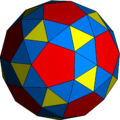 Snub dodecahedron or Snub icosidodecahedron |



In general, snubs have chiral symmetry with two forms: with clockwise or counterclockwise orientation. By Kepler's names, a snub can be seen as an expansion of a regular polyhedron: moving the faces apart, twisting them about their centers, adding new polygons centered on the original vertices, and adding pairs of triangles fitting between the original edges.
The terminology was generalized by Coxeter, with a slightly different definition, for a wider set of uniform polytopes.
Remove ads
Conway snubs
John Conway explored generalized polyhedron operators, defining what is now called Conway polyhedron notation, which can be applied to polyhedra and tilings. Conway calls Coxeter's operation a semi-snub.[2]
In this notation, snub is defined by the dual and gyro operators, as s = dg, and it is equivalent to an alternation of a truncation of an ambo operator. Conway's notation itself avoids Coxeter's alternation (half) operation since it only applies for polyhedra with even-sided faces.
In 4-dimensions, Conway suggests the snub 24-cell should be called a semi-snub 24-cell because, unlike 3-dimensional snub polyhedra are alternated omnitruncated forms, it is not an alternated omnitruncated 24-cell. It is instead actually an alternated truncated 24-cell.[3]
Remove ads
Coxeter's snubs, regular and quasiregular
Summarize
Perspective
Coxeter's snub terminology is slightly different, meaning an alternated truncation, deriving the snub cube as a snub cuboctahedron, and the snub dodecahedron as a snub icosidodecahedron. This definition is used in the naming of two Johnson solids: the snub disphenoid and the snub square antiprism, and of higher dimensional polytopes, such as the 4-dimensional snub 24-cell, with extended Schläfli symbol s{3,4,3}, and Coxeter diagram ![]()
![]()
![]()
![]()
![]()
![]()
![]() .
.
A regular polyhedron (or tiling), with Schläfli symbol , and Coxeter diagram ![]()
![]()
![]()
![]()
![]() , has truncation defined as , and
, has truncation defined as , and ![]()
![]()
![]()
![]()
![]() , and has snub defined as an alternated truncation , and
, and has snub defined as an alternated truncation , and ![]()
![]()
![]()
![]()
![]() . This alternated construction requires q to be even.
. This alternated construction requires q to be even.
A quasiregular polyhedron, with Schläfli symbol or r{p,q}, and Coxeter diagram ![]()
![]()
![]() or
or ![]()
![]()
![]()
![]()
![]() , has quasiregular truncation defined as or tr{p,q}, and
, has quasiregular truncation defined as or tr{p,q}, and ![]()
![]()
![]() or
or ![]()
![]()
![]()
![]()
![]() , and has quasiregular snub defined as an alternated truncated rectification or htr{p,q} = sr{p,q}, and
, and has quasiregular snub defined as an alternated truncated rectification or htr{p,q} = sr{p,q}, and ![]()
![]()
![]() or
or ![]()
![]()
![]()
![]()
![]() .
.
For example, Kepler's snub cube is derived from the quasiregular cuboctahedron, with a vertical Schläfli symbol , and Coxeter diagram ![]()
![]()
![]() , and so is more explicitly called a snub cuboctahedron, expressed by a vertical Schläfli symbol , and Coxeter diagram
, and so is more explicitly called a snub cuboctahedron, expressed by a vertical Schläfli symbol , and Coxeter diagram ![]()
![]()
![]() . The snub cuboctahedron is the alternation of the truncated cuboctahedron, , and
. The snub cuboctahedron is the alternation of the truncated cuboctahedron, , and ![]()
![]()
![]() .
.
Regular polyhedra with even-order vertices can also be snubbed as alternated truncations, like the snub octahedron, as , ![]()
![]()
![]()
![]()
![]() , is the alternation of the truncated octahedron, , and
, is the alternation of the truncated octahedron, , and ![]()
![]()
![]()
![]()
![]() . The snub octahedron represents the pseudoicosahedron, a regular icosahedron with pyritohedral symmetry.
. The snub octahedron represents the pseudoicosahedron, a regular icosahedron with pyritohedral symmetry.
The snub tetratetrahedron, as , and ![]()
![]()
![]() , is the alternation of the truncated tetrahedral symmetry form, , and
, is the alternation of the truncated tetrahedral symmetry form, , and ![]()
![]()
![]() .
.
Coxeter's snub operation also allows n-antiprisms to be defined as or , based on n-prisms or , while is a regular n-hosohedron, a degenerate polyhedron, but a valid tiling on the sphere with digon or lune-shaped faces.
The same process applies for snub tilings:
Examples
Nonuniform snub polyhedra
Nonuniform polyhedra with all even-valance vertices can be snubbed, including some infinite sets; for example:
 |
| Snub square bipyramid |
|---|
 |
| Snub hexagonal bipyramid |
 |
Coxeter's uniform snub star-polyhedra
Snub star-polyhedra are constructed by their Schwarz triangle (p q r), with rational ordered mirror-angles, and all mirrors active and alternated.
 s{3/2,3/2} |
 s{(3,3,5/2)} |
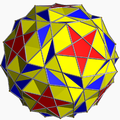 sr{5,5/2} |
 s{(3,5,5/3)} |
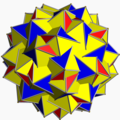 sr{5/2,3} |
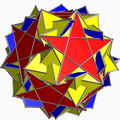 sr{5/3,5} |
 s{(5/2,5/3,3)} |
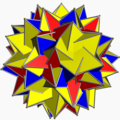 sr{5/3,3} |
 s{(3/2,3/2,5/2)} |
 s{3/2,5/3} |
Coxeter's higher-dimensional snubbed polytopes and honeycombs
In general, a regular polychoron with Schläfli symbol , and Coxeter diagram ![]()
![]()
![]()
![]()
![]()
![]()
![]() , has a snub with extended Schläfli symbol , and
, has a snub with extended Schläfli symbol , and ![]()
![]()
![]()
![]()
![]()
![]()
![]() .
.
A rectified polychoron = r{p,q,r}, and ![]()
![]()
![]()
![]()
![]()
![]()
![]() has snub symbol = sr{p,q,r}, and
has snub symbol = sr{p,q,r}, and ![]()
![]()
![]()
![]()
![]()
![]()
![]() .
.
Examples

There is only one uniform convex snub in 4-dimensions, the snub 24-cell. The regular 24-cell has Schläfli symbol, , and Coxeter diagram ![]()
![]()
![]()
![]()
![]()
![]()
![]() , and the snub 24-cell is represented by , Coxeter diagram
, and the snub 24-cell is represented by , Coxeter diagram ![]()
![]()
![]()
![]()
![]()
![]()
![]() . It also has an index 6 lower symmetry constructions as or s{31,1,1} and
. It also has an index 6 lower symmetry constructions as or s{31,1,1} and ![]()
![]()
![]()
![]() , and an index 3 subsymmetry as or sr{3,3,4}, and
, and an index 3 subsymmetry as or sr{3,3,4}, and ![]()
![]()
![]()
![]()
![]()
![]()
![]() or
or ![]()
![]()
![]()
![]()
![]() .
.
The related snub 24-cell honeycomb can be seen as a or s{3,4,3,3}, and ![]()
![]()
![]()
![]()
![]()
![]()
![]()
![]()
![]() , and lower symmetry or sr{3,3,4,3} and
, and lower symmetry or sr{3,3,4,3} and ![]()
![]()
![]()
![]()
![]()
![]()
![]()
![]()
![]() or
or ![]()
![]()
![]()
![]()
![]()
![]()
![]() , and lowest symmetry form as or s{31,1,1,1} and
, and lowest symmetry form as or s{31,1,1,1} and ![]()
![]()
![]()
![]()
![]() .
.
A Euclidean honeycomb is an alternated hexagonal slab honeycomb, s{2,6,3}, and ![]()
![]()
![]()
![]()
![]()
![]()
![]() or sr{2,3,6}, and
or sr{2,3,6}, and ![]()
![]()
![]()
![]()
![]()
![]()
![]() or sr{2,3[3]}, and
or sr{2,3[3]}, and ![]()
![]()
![]()
![]()
![]() .
.
Another Euclidean (scaliform) honeycomb is an alternated square slab honeycomb, s{2,4,4}, and ![]()
![]()
![]()
![]()
![]()
![]()
![]() or sr{2,41,1} and
or sr{2,41,1} and ![]()
![]()
![]()
![]()
![]() :
:
The only uniform snub hyperbolic uniform honeycomb is the snub hexagonal tiling honeycomb, as s{3,6,3} and ![]()
![]()
![]()
![]()
![]()
![]()
![]() , which can also be constructed as an alternated hexagonal tiling honeycomb, h{6,3,3},
, which can also be constructed as an alternated hexagonal tiling honeycomb, h{6,3,3}, ![]()
![]()
![]()
![]()
![]()
![]()
![]() . It is also constructed as s{3[3,3]} and
. It is also constructed as s{3[3,3]} and ![]()
![]()
![]() .
.
Another hyperbolic (scaliform) honeycomb is a snub order-4 octahedral honeycomb, s{3,4,4}, and ![]()
![]()
![]()
![]()
![]()
![]()
![]() .
.
Remove ads
See also
References
Wikiwand - on
Seamless Wikipedia browsing. On steroids.
Remove ads



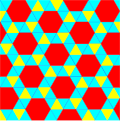

 ,
,  ...
...


















 ...
...

































 ...
...











 ...
...





















